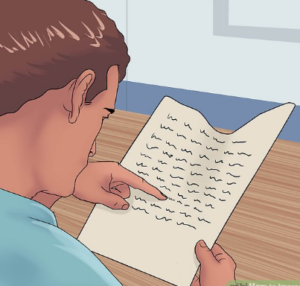To increase your continuous learning, what skill would you choose? I would choose to increase learning by improving reading skills. Let me explain.

Reading … this is how Warren Buffett, one of the most successful people in the business world, describes his day.
Sitting. Reading. He advises everyone to read more, and that’s certainly a goal we can all get behind.
So how do we do it? And what are we to do with all that information once we have it?
Reading more and remembering it all is a discussion with a lot of different layers and a lot of interesting possibilities.
Improving reading skills relates to reading more books, better comprehension, and, of course, faster reading.
Let’s discuss these options and how best to achieve them.
More books
Reading innovation
Is there still room for innovation in reading? A couple of new reading tools say yes.
Spritz and Blinkist take unique approaches to help you read more—one helps you read faster and the other helps you digest books quicker.
Improving reading skills … Spritz
First, the Spritz approach. As mentioned above, there is a lot of wasted movement when reading side-to-side and top-to-bottom.
Spritz cuts all the movement out entirely.
Spritz shows one word of an article or book at a time inside a box. Each word is centered in the box according to the Optimal Recognition Point—Spritz’s term for the place in a word that the eye naturally seeks—and this center letter is colored red.
Spritz has yet to launch anything related to its technology, but there is a bookmarklet called OpenSpritz, created by gun.io, that lets you use the Spritz reading method on any text you find online.
The Spritz website has a demo on the homepage that you can try for yourself and speed up or slow down the speeds as you need.
Improving reading skills … Blinkist
Along with Spritz is the new app Blinkist. Rather than a reimagining of the way we read, Blinkist is a reimagining of the way we consume books.
Based on the belief that the wisdom of books should be more accessible to us all, Blinkist takes popular works of non-fiction and breaks the chapters down into bite-sized parts.
These so-called “blinks” contain key insights from the books, and they are meant to be read in two minutes or less. It is very similar to Cliff Notes.
Though the way the information is delivered—designed to look great and be eminently usable on mobile devices so you can learn wherever you are—makes it one-of-a-kind.
Surely we can agree that it’s a lot easier to read more when a book is distilled into 10 chapters, two minutes each.
Focus on the four levels of reading
Mortimer Adler’s book, How to Read a Book, identifies four levels of reading with each step building upon the previous step.
Elementary reading is what you are taught in school.
Inspectional reading can take two forms: 1) a quick, leisurely read or 2) skimming the book’s preface, table of contents, index, and inside the jacket.
Where the real work (and the real retention begins) is with analytical reading and syntopical reading.
With analytical reading, you read a book thoroughly. More so than that even, you read a book according to your rules, which should help you with the context and understanding of the book.
Classify the book according to the subject matter.
State what the whole book is about. Be as brief as possible.
List the major parts in order and relation. Outline these parts as you have outlined the whole.
Define the problem or problems the author is trying to solve.
The final level of reading is syntopical, which requires that you read books on the same subject and challenge yourself to compare and contrast as you go.
As you advance through these levels, you will find yourself incorporating the brain techniques of impression, association, and repetition along the way.

Improving reading skills … better comprehension
Be a close reader for comprehension
Let’s face it, close reading isn’t often a skill that comes naturally with many of us.
Our first instinct is often to race to the finish line rather than engage deeply with a text.
Getting readers to slow down, engage with the text in different ways, and reflect as they read are the goals of close reading.
There are specific close reading skills you can learn that will help.
The key is learning how to annotate effectively. Nurturing these skills takes time.
Once you are familiar with close reading in one content area, expand the process to other texts and content areas.
Remember what you read
A great place to start with book retention is with understanding some key ways our brain stores information. Here are three specific elements to consider:
Impression
Association
Repetition
Let’s say you read Dale Carnegie’s How to Win Friends and Influence People. You loved the information and want to remember as much as possible.
Here’s what is recommended:
Impression – Be impressed with the text. Stop and picture a scene in your mind, even adding elements like greatness, shock, or a cameo from yourself to make the impression stronger.
If Dale Carnegie is explaining his distaste for criticism, picture yourself receiving the Nobel Prize for Peace and then spiking the Nobel Prize onto the dais.
Association – Link the text to something you already know. This technique is used to great effect with memorization and the construction of memory palaces.
In the case of Carnegie’s book, if there is a particular principle you wish to retain, think back to a time when you were part of a specific example involving the principle. Prior knowledge is a great way to build the association.
Repetition – The more you repeat, the more you remember. This can occur by literally re-reading a certain passage or in highlighting it or writing it down then returning to it again later.
Practicing these three elements of remembering will help you get better and better. The more you work at it, the more you’ll retain.
Keep the book and your notes close
One of the most common threads in my research into remembering more of the books you read is this: Take good notes.
Scribble in the margins as you go.
Bookmark your favorite passages.
Write a review when you’ve finished.
Use your Kindle Highlights extensively.
And when you’ve done these things, return to your notes periodically to review and refresh.
I’ve tried this method for myself, and it has completely changed the way I learn and connect information from perceiving the books I read.
Kindle has a helpful feature online, too, where it shows you a daily, random highlight from your archive of highlights. It’s a great way to relive what you’ve read in the past.
https://digitalsparkmarketing.com/ibm-simplifies-life/
Improving reading skills … faster reading

One of the obvious shortcuts to reading more is to read faster. That’s likely the first place a lot of us would look for a quick win in improvement.
So how fast do you read?
Staples, the office supply chain, collected speed reading data as part of an advertising campaign for selling e-readers.
The campaign also included a speed reading tool that is available for you to evaluate. Go ahead and take the test to see how you compare to others.
The Staples speed reading test includes data on how other demographics stack up in words per minute. According to Staples, the average adult reads 300 words per minute.
Third-grade students = 150 words per minute
Eight grade students = 250
Average college student = 450
Average “high-level exec” = 575
Average college professor = 675
Speed readers = 1,500
World speed reading champion = 4,700
Is reading faster always the right solution to the goal of reading more? Not always. Comprehension is as important or maybe more. Some reports say that speed reading or skimming leads to poor retention.
Still, if you can bump up your words per minute marginally while still maintaining your reading comprehension, it can certainly pay dividends in your quest to read more.
Tim Ferriss, the author of the 4-Hour Workweek and a handful of other bestsellers, is one of the leading voices in lifehacks, experiments, and getting things done. So it’s not surprising he has a speed-reading method to boost your reading speed threefold.
His plan contains two techniques:
Using a pen as a tracker and pacer, like how some people move their finger back and forth across a line as they read.
Begin reading each new line at least three words in from the first word of the line and end at least three words in from the last word.
The first technique, the tracker/pacer, is mostly a tool to use for mastering the second technique. Ferriss calls this second technique Perceptual Expansion. According to Ferriss:
Untrained readers use up to ½ of their peripheral field on margins by moving from 1st word to last, spending 25-50% of their time “reading” margins with no content.

Call today for a FREE consultation or a FREE quote. Learn about some options to scope your job.
Call Mike at 607-725-8240.
All you get is what you bring to the fight. And that fight gets better every day you learn and apply new ideas.
When things are not what you want them to be, what’s most important is your next step. Call today.
Test. Learn. Improve. Repeat.
Are you devoting enough energy continually improving your continuous learning?
Digital Spark Marketing will stretch your thinking and your ability to adapt to change. We also provide some fun and inspiration along the way. Call us for a free quote today. You will be amazed how reasonable we will be.
More reading on learning from Digital Spark Marketing’s Library:
9 Things to Know About Creative Visual Design Content
8 Presenter Mistakes That Are Rarely Made Twice
Know These Great Secrets of Collaboration and Co-Creation
How Good Is Your Learning from Failure?
Mike Schoultz is a digital marketing and customer service expert. With 48 years of business experience, he consults on and writes about topics to help improve the performance of small business. Find him on G+, Facebook, Twitter, Digital Spark Marketing, and LinkedIn.